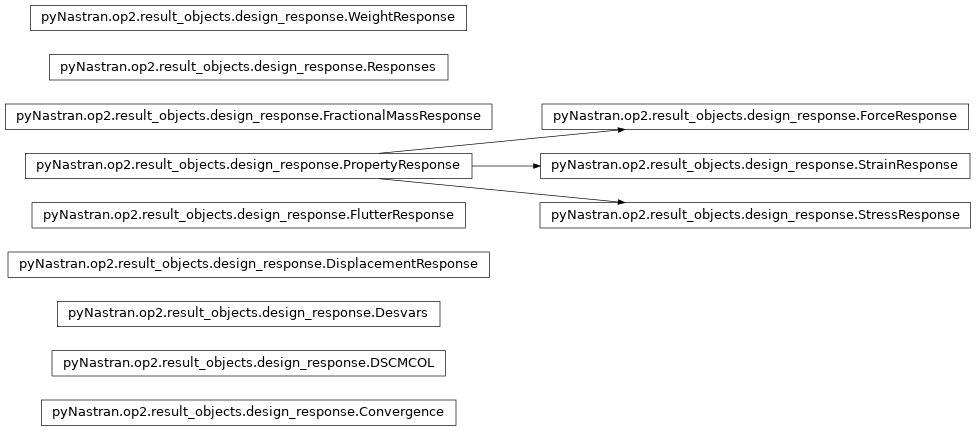op2/result_objects Package¶
design_response Module¶

-
class
pyNastran.op2.result_objects.design_response.Convergence(ndesign_variables)[source]¶ Bases:
object
-
class
pyNastran.op2.result_objects.design_response.DSCMCOL(responses)[source]¶ Bases:
object‘ —– IDENTIFICATION OF COLUMNS IN THE DESIGN SENSITIVITY —–’ ‘ —– MATRIX THAT ARE ASSOCIATED WITH DRESP1 ENTRIES —–’ ‘’ ‘’ ‘ —– WEIGHT/VOLUME RESPONSES —–’ ‘ ——————————————’ ‘ COLUMN DRESP1 RESPONSE’ ‘ NO. ENTRY ID TYPE ‘ ‘ ——————————————’ ‘ 1 1 WEIGHT ‘ ‘’ ‘’ ‘ —– STATICS RESPONSES —–’ ‘ ————————————————————————————————————————’ ‘ COLUMN DRESP1 RESPONSE GRID/ELM VIEW COMPONENT SUB PLY ‘ ‘ NO. ENTRY ID TYPE ID ELM ID NO. CASE NO. ‘ #’ COLUMN DRESP1 RESPONSE GRID/ELM VIEW COMPONENT SUB ‘ #’ NO. ENTRY ID TYPE ID ELM ID NO. CASE ‘ ‘ ————————————————————————————————————————’ ‘ 2 2 STRESS 1 5 1’ ‘ 3 2 STRESS 3 5 1’ ‘ 4 10501 DISP 100 1 1’ ‘’ ‘’ #’ —- RETAINED DRESP2 RESPONSES —-’ #’’ #’ ———————————————————————————————————-’ #’ INTERNAL DRESP2 RESPONSE EQUATION LOWER UPPER ‘ #’ ID ID LABEL ID BOUND VALUE BOUND ‘ #’ ———————————————————————————————————-’ #’ 3 105 DISPMAG 3 -1.0000E+20 9.4677E-05 2.5000E-04’ ‘ —– IDENTIFICATION OF COLUMNS IN THE DESIGN SENSITIVITY —–’ ‘ —– MATRIX THAT ARE ASSOCIATED WITH DRESP2 ENTRIES —–’ ‘’ ‘’ ‘ ———————————————————-’ ‘ COLUMN DRESP2 SUB FREQ/ ‘ ‘ NO. ENTRY ID CASE TIME ‘ ‘ ———————————————————-’ ‘ 96 103 0 0.00000’ ‘ 97 104 0 0.00000’ ‘ 100 105 1’
internal_response_id = iresponse + 1 = column in DSCM2
-
property
external_ids¶
-
property
names¶
-
property
-
class
pyNastran.op2.result_objects.design_response.DisplacementResponse[source]¶ Bases:
object-
append(internal_id, dresp_id, response_label, region, subcase, type_flag, seid, nid, component)[source]¶
-
name= 'displacement'¶
-
-
class
pyNastran.op2.result_objects.design_response.FlutterResponse[source]¶ Bases:
object-
append(internal_id, dresp_id, response_label, region, subcase, type_flag, seid, mode, mach, velocity, density, flutter_id)[source]¶
-
name= 'flutter'¶
-
-
class
pyNastran.op2.result_objects.design_response.ForceResponse[source]¶ Bases:
pyNastran.op2.result_objects.design_response.PropertyResponse-
name= 'force'¶
-
-
class
pyNastran.op2.result_objects.design_response.FractionalMassResponse[source]¶ Bases:
object-
name= 'fractional_mass'¶
-
-
class
pyNastran.op2.result_objects.design_response.PropertyResponse[source]¶ Bases:
objectcommon class for StressResponse, StrainResponse, and ForceResponse
-
class
pyNastran.op2.result_objects.design_response.Responses[source]¶ Bases:
objectDefines SOL 200 responses from the R1TABRG table
-
class
pyNastran.op2.result_objects.design_response.StrainResponse[source]¶ Bases:
pyNastran.op2.result_objects.design_response.PropertyResponse-
name= 'strain'¶
-
-
class
pyNastran.op2.result_objects.design_response.StressResponse[source]¶ Bases:
pyNastran.op2.result_objects.design_response.PropertyResponse-
name= 'stress'¶
-
-
class
pyNastran.op2.result_objects.design_response.WeightResponse[source]¶ Bases:
object-
add_from_op2(out, log)[source]¶ Weight Response
1 IRID I Internal response identification number 2 RID I External response identification number 3 TYPE(C) I Response type 4 LABEL(2) CHAR4 Label 6 REGION I Region identifier 7 SCID I Subcase identification number 8 UNDEF(2) I Not used 10 SEID I Superelement identification number or ALL 11 UNDEF(2) I Not used
13 UNDEF I Not used 14 TYFLG I Flag to indicate how response is referenced 15 SEID I Superelement identificaiton number
—> 3i 8s 7i 3i
# —– WEIGHT RESPONSE —– # ——————————————————————————— # INTERNAL DRESP1 RESPONSE ROW COLUMN LOWER INPUT OUTPUT UPPER # ID ID LABEL ID ID BOUND VALUE VALUE BOUND # ——————————————————————————— # 1 1 WEIGHT 3 3 N/A 2.9861E+05 2.9852E+05 N/A
# ? ? ? LABEL? ? ? ROW_ID? COL_ID? ? ? ? ? ? ? #(1, 1, 1, ‘WEIGHT ‘, 0, 1011, 3, 3, 0, 0, 0, 0, 0, 0) #(1, 1000, 1, ‘W ‘, 0, 1, 3, 3, 0, 0, 0, 0, 0, 0) # # per dev forum; 538976288 is probably just ‘ ‘ #(1, 1, 1, ‘WEIGHT ‘, 0, 1, 3, 3, 0, 0, 538976288, 538976288, 0, 0)
-
grid_point_weight Module¶
#.. inheritance-diagram:: pyNastran.op2.result_objects.grid_point_weight
defines the GridPointWeight class
-
class
pyNastran.op2.result_objects.grid_point_weight.GridPointWeight(reference_point, MO, S, mass, cg, IS, IQ, Q, approach_code=1, table_code=13, title='', subtitle='', label='', superelement_adaptivity_index='')[source]¶
-
pyNastran.op2.result_objects.grid_point_weight.make_grid_point_weight(reference_point, MO, approach_code=1, table_code=13, title='', subtitle='', label='', superelement_adaptivity_index='') → None[source]¶ creates a grid point weight table
# :show-inheritance:
matrix Module¶
#.. inheritance-diagram:: pyNastran.op2.result_objects.matrix
Defines the Matrix class
-
class
pyNastran.op2.result_objects.matrix.Matrix(name, form, is_matpool=False)[source]¶ Defines a Matrix object that’s stored in op2.matrices
- Attributes
- namestr
the name of the matrix
- datavaries
dense : np.ndarray sparse : coo_matrix data is initialized by setting the matrix.data attribute externally
- is_matpoolbool
is this a matpool matrix
Initializes a Matrix
- Parameters
- namestr
the name of the matrix
- formint
the matrix type
- is_matpoolbool
is this a matpool matrix
- +——+—————–+
- | Form | Meaning |
- +======+=================+
- | 1 | Square |
- | 2 | Rectangular |
- | 6 | Symmetric |
- | 9 | Pseudo identity |
- +——+—————–+
-
property
shape_str¶ gets the matrix description
-
class
pyNastran.op2.result_objects.matrix.MatrixDict(name)[source]¶ storage object for KDICT, MDICT, BDICT, etc. is op2.matdicts
-
add(eltype, numwids, numgrid, dof_per_grid, form, eids, ge, address, sil, xform=None)[source]¶ Sets the next set of the KDICT
-
property
element_names¶
-
property
nelements¶
-
# :show-inheritance:
monpnt Module¶
#.. inheritance-diagram:: pyNastran.op2.result_objects.monpnt
-
class
pyNastran.op2.result_objects.monpnt.MONPNT1(frequencies, matrices, comp_matrices)[source]¶ MONPNT1 table
# :show-inheritance: